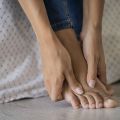5 Surprising Causes of Foot Pain

Feet are a complex part of your body that consist of many different bones and muscles on which you rely heavily throughout the day. For this reason, your feet are susceptible to different problems with the bones, muscles, or nerves. Not taking care of your feet or having previous foot injuries might increase the risk of foot pain.
If you experience foot pain, you might be wondering what’s causing it. Learn more about the common cause of foot pain and ways to deal with them.
1. Plantar fasciitis
One of the most common reasons for foot pain is plantar fasciitis. Plantar fasciitis is the inflammation of a thick band of tissue that runs across the bottom of each foot and links the heel bone to the toes (plantar fascia).
Plantar fasciitis is characterized by sharp pain that occurs with your first steps in the morning. The discomfort usually subsides when you start walking more, but it may reappear after prolonged periods of standing or when you rise up after sitting. To prevent complications and reduce discomfort, it is crucial to seek plantar fasciitis treatment.
2. Ingrown toenail
An ingrown toenail is probably the most visible sign of foot pain in which the corner or side of a toenail grows into the soft flesh. Ingrown toenails are typically inflamed, extremely sensitive, and may lead to the development of calluses or even pus-filled deposits surrounding the affected toe.
Ingrown toenails can often be treatable on your own. If the pain is severe or spreading, a foot doctor can help you reduce your discomfort and avoid ingrown toenail issues. If you have diabetes or another illness that causes poor blood flow to your feet, you are at a higher risk of ingrown toenail complications.
3. Wrong-sized shoes
Up to 70% of individuals wear shoes that aren’t suitable for the width or length measurements of their feet (shoes that are too small). Ill-fitting shoes are probably the most common cause of foot pain. Properly fitting shoes can reverse detrimental effects and provide appropriate support, stabilize, and realign the body.
How can you tell whether your shoes are too tight, too loose, too thin, or too wide? First, try mapping out your foot type. Cover your foot in baby powder and step on the piece of black paper. A person with a higher arch will have a narrow profile on the bottom of their foot, whereas a wider footprint indicates a flat foot type. If your shoe and the footprint you get don't resemble each other, that's a warning sign that you are wearing shoes that aren’t suitable for you.
4. Bunion
A bunion is a bony lump that develops at the base of your big toe's joint. Smaller bunions (bunionettes) might form on your little toe's joint. A bunion develops when some of the bones in the front of your foot shift from their position. This pulls the tip of your big toe toward the smaller toes, causing the joint at the base of your big toe to protrude. The skin above the bunion may be red and inflamed.
Wearing tight, narrow shoes may cause or aggravate bunions. Bunions can also arise as a result of your foot's shape, a foot deformity, or a medical condition like arthritis. It is crucial to seek medical help if you have a bunion.
5. Corns or calluses
Foot pain is commonly caused by corns and calluses. These blister-like formations develop because of a variety of factors like ill-fitting shoes or pressure areas on your foot. They are the result of repeated friction. Calluses frequently cause cracked, exposed skin that is easily irritated. Corns are inflamed patches on your skin that are quite painful when squeezed.
Calluses and corns can be treated by wearing proper shoes and reducing friction in a specific location. However, certain calluses and corns may be caused by the anatomy of your foot. Ask your doctor about the ways to address this issue.
Other articles and publications:
Articles and publications of other companies:
- +1 (646) 270-9836
- Long Island City
- grantny.com











